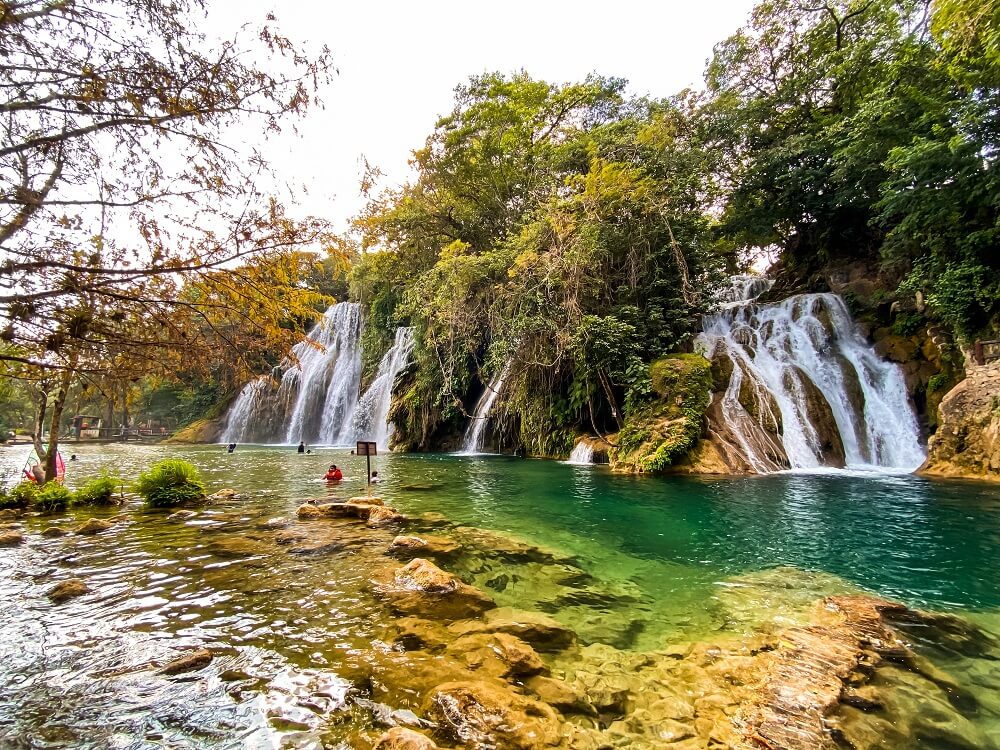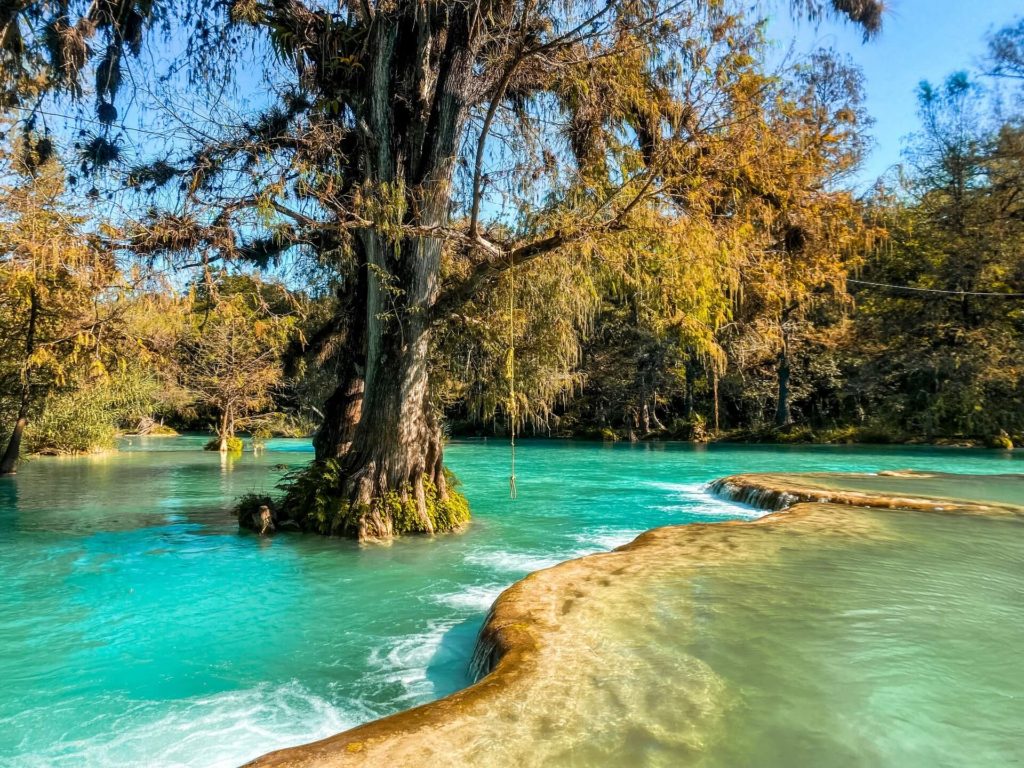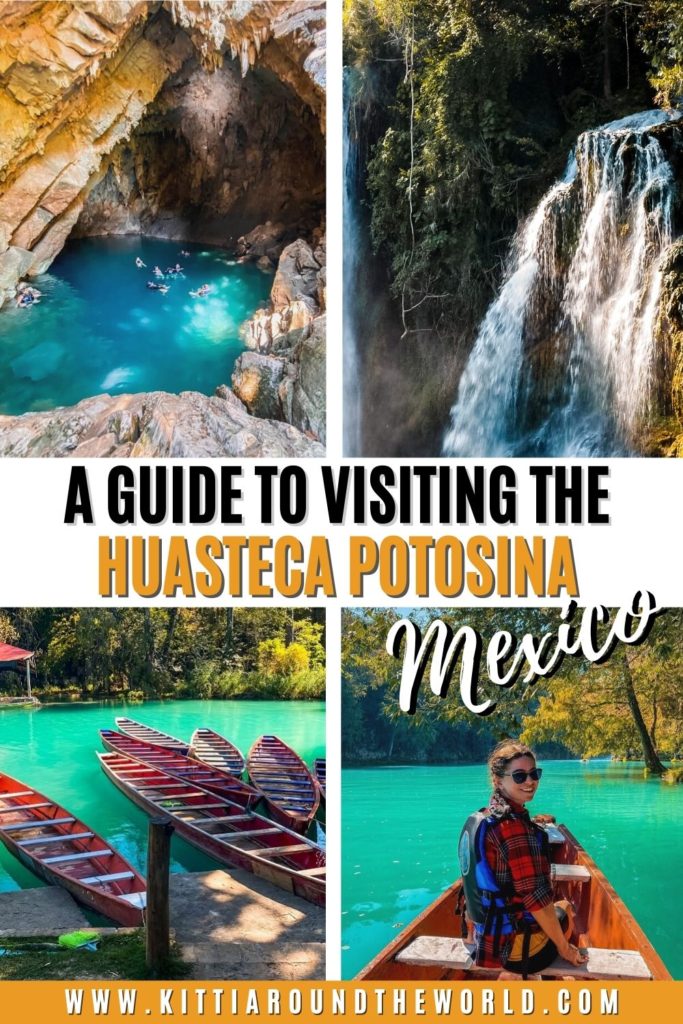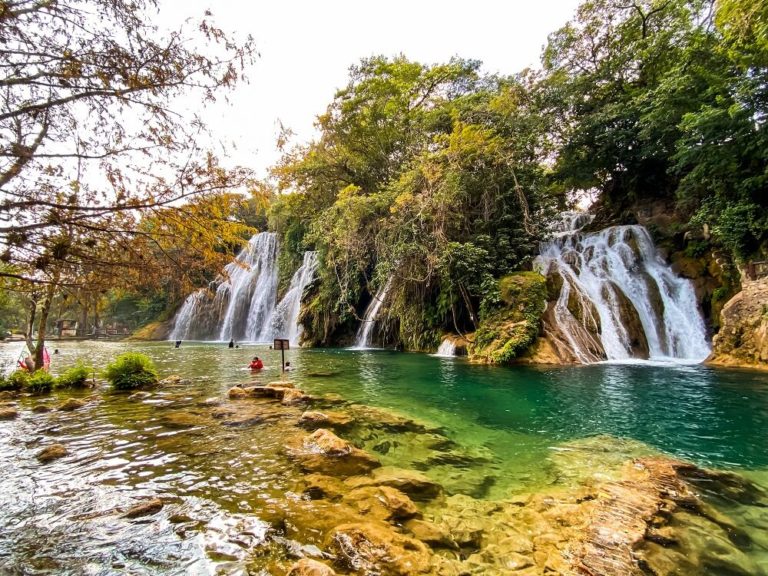How to Visit the Huasteca Potosina Region in Mexico
Are you dreaming about swimming in the most turquoise blue waters, seeing impressive waterfalls cascading into rivers or doing something more adventurous like paddling, cliff jumping or rappelling? If your answer is a big yes to any of those, then you have to plan a visit to the Huasteca Potosina region of Mexico.
This blog post will give you a good overview of the Huasteca Potosina, how to get there, ways to move around the region and most importantly a list of places you should put onto your itinerary. You’ll also be able to read a more detailed blog post about each of these destinations.
For reference, we spent a full week touring around the region during our 3 months in Mexico. We fell in love with this area instantly. Even after completing our full itinerary around Mexico, this region remained our absolute favourite.
Disclosure: This post may contain affiliate links, which means we may receive a small commission if you click a link and purchase something. Clicking these links won’t cost you anything, but it will help us to keep this site up and running! Learn more about our affiliate policy.

About the Huasteca Potosina Region
I’d never heard of this place before we started planning our Mexico adventures. In fact it wasn’t even on our original itinerary until I stumbled upon an article about it.
So what is the Huasteca Potosina exactly?
The Huasteca Potosina is a region located within the state of San Luis Potosi and it’s also part of the much bigger ‘La Huasteca’ area. This bigger region includes parts of the states of Tamaulipas, Veracruz, Puebla, Hidalgo, Queretaro and Guanajuato. It is basically the area where the Huastec people once lived.
With over 2,000 species of plants, La Huasteca is definitely one of the most bio-diverse regions in the country.
Did you know? – La Huasteca is also considered one of the poorest regions in Mexico. Its economy is based on agriculture. If you travel through this area you’ll notice a huge amount of sugarcane fields. This area is actually one of the top sugar producing areas in Mexico. The industry employs a lot of people who work in various parts of the production. We saw many people harvesting on the fields and passed many lorries carrying the sugarcane to the factories.
In summary, this area is filled with waterfalls, turquoise blue waters, natural pools, canyons and caves. It has everything you’d want for an unforgettable adventure.

Is It Safe to Visit the Huasteca Potosina?
We never felt unsafe travelling around the Huasteca Potosina region. Whilst Ciudad Valles and Xilitla might look a bit rough around the edges, there’s nothing to worry about. Tourism provides a significant amount of income to this region, therefore the areas you’re likely to be visiting are well protected.
Obviously, crime is not uncommon. Many articles suggest that the state of Tamaulipas is not safe to travel to due to increased crime activities. You might also read some scary stories that happened to people in nearby states who were unfortunately in the wrong place at the wrong time, but in my opinion this is very rare.
If you’re vigilant and practice general safety measures such as not carrying too many valuables, not leaving them unattended, not going out alone at night and driving during the day when you can, then you’ll likely have nothing to worry about.
Do People Speak English in the Huasteca Potosina?
I think it’s a very important question to answer before you start packing your bags.
There will be significantly less English speakers in the Huasteca Potosina area than you would expect in more touristy areas. Therefore, my biggest advice is to learn some Spanish phrases based around ordering food, buying bus tickets, booking activities, asking for prices, and numbers. Practicing a country’s native language is always nice and people will appreciate your efforts.
Luckily, many tour companies will communicate via Whatsapp, so you can use Google Translate which can be a lifesaver.
This doesn’t mean that nobody speaks English. We actually had one guide who spoke English and could go on an English speaking tour in Xilitla. In addition, we also ran into people literally in the middle of nowhere who spoke perfectly good English.
You can always ask the person if they speak English first, but come prepared in case they don’t.

How to Get to the Huasteca Potosina
By Plane: There are two airports you can fly to to get to the Huasteca Potosina region: San Luis Potosi or Tampico. Tampico might be slightly closer to the places you’d like to travel to and the flight tickets will be cheaper too from Mexico City. However, the state of Tampico is considered a bit unsafe to travel to, so bear that in mind when planning your trip. San Luis Potosi is also a great alternative and will have connections to other cities such as Ciudad Valles where you will want to be based. It all depends on the method you choose for traveling around the region during your stay which I’ll detail below.
Find Flights to the Huasteca Potosina Region✈️
By Car: You can opt to rent a car and drive to Ciudad Valles. We didn’t rent a car during our stay in Mexico. Whilst I have no personal experience or recommendations, I read plenty of useful blog posts about everything you need to know about car rental in Mexico. Discover Cars has been recommended on multiple websites where you can find the best rates as it compares local, national and international companies.
I highly suggest doing thorough research to avoid any problems and extra costs.
By Bus: Since we’ve decided to fly as little as possible during our trip, we mainly travel by buses between cities. Although it will take you longer to get to places, they are cheaper, surprisingly spacious and comfortable. There are many different bus companies running services to San Luis Potosi or Ciudad Valles from big cities such as Mexico City and Guadalajara.
Click here for a detailed blog post about travelling in Mexico by bus.
Top Tip – A very useful website we use all the time when planning our longer trips between cities is Rome2rio.

Best Ways to Move Around the Huasteca Potosina
There are a few options to explore the Huasteca Potosina. We used a mixture of public buses and tours which I’ll get into a bit more detail about under each location.
By Private Car: Hiring a car will give you the freedom to visit as many places as you’d like to in your own time. Although we didn’t hire a car, I’d like to warn you that the roads are considerably worse here than in other parts of Mexico so make sure to drive carefully and pick the right insurance for your needs. In addition, I also suggest doing detailed research about car rental and safety prior to your trip.
By Local Bus: Luckily, there are some public buses operating between a few of the must see locations within the Huasteca Potosina. Whilst we felt completely safe taking these, it can be slightly confusing as to when and where they depart from. Therefore, I’ll have a very detailed guide on each of the places you can visit by public transport.
By Tour: Unfortunately you won’t be able to get to all of the places by public transport. Unless you have your own vehicle, the best way to visit some of these amazing waterfalls will be via a tour. I’ll have a detailed guide on the tours we took to some of these must see spots.


Where to Stay in the Huasteca Potosina
Depending on the method you choose to travel around the region, there are a few places you can base yourself in. For reference, we spent 5 days in Ciudad Valles and an extra 2 days in Xilitla.
Ciudad Valles: Whilst the city is probably one of the least attractive places we visited during our 3 months in Mexico, it is ideally located around all the main attractions in the region. It has plenty of hotels, markets, supermarkets and restaurants. The majority of public buses run through Ciudad Valles along with most of the main tour operators being based there. Therefore, if you’re also relying on public transport and tours in order to see everything I highly recommend booking your accommodation in Ciudad Valles. From there you can also hop onto a long-haul bus to other places such as Mexico City.
Xilitla: It is a much smaller town nestled in the mountains about two hours south of Ciudad Valles. Many attractions are located closer to Xilitla, as well as plenty of tour operators. Therefore, it’s another great place to be based for a few nights. The town itself had way more charm than Ciudad Valles which made us instantly fall in love with it.
San Luis Potosi: Some people might consider basing themselves in the capital city of the state of San Luis Potosi which is also called San Luis Potosi. However, I think it’s quite far from the Huasteca Potosina and you would need to have an early start for your day trips.
Best Time to Visit the Huasteca Potosina
You can technically visit the Huasteca Potosina all year round. However, for the best experience I would time my visit during the dry season between November and March.
During the wet/ rainy season you’ll definitely see all the waterfalls in full capacity. However, the heavy rains will make the currents stronger and the colour of the water less turquoise blue.
I would check and avoid visiting during bigger Mexican holidays. Weekends are also busier, so try to do some of the activities like Tamul Waterfall during a weekday.
For reference we visited the region in mid-December (just before Christmas) and we were treated with blue skies, turquoise blue waters and still relatively strong waterfalls.
Must Visit Places in the Huasteca Potosina
There are no shortage of stunning places and unforgettable things to do in the Huasteca Potosina region. Whether you’re after seeing some stunning waterfalls, swimming in the most turquoise blue waters or doing something more adventurous like paddling, cliff jumping or rappelling you won’t go home disappointed.
I divided the places you should consider visiting into 4 main areas:
1. Waterfalls and Caves Around Ciudad Valles
There are quite a few waterfalls and other natural formations you should consider visiting especially if you’re after a bit of an adventure. All of these places are located relatively close to Ciudad Valles.
Read my detailed blog post on how to visit Cascada de Tamul and the Cave of Swallows.


Cascada de Tamul
You can’t miss a trip to the tallest waterfall in the state of San Luis Potosi when visiting the Huasteca Potosina region. Cascada de Tamul is a 105 m tall and about 300 m wide waterfall located to the southwest of Ciudad Valles.
The most common way to get close to the waterfall is via the Tampaon River in colourful wooden boats called ‘pangas’. There are no motorboats allowed in order to protect the river which means you’ll have to row with the others in your boat. Along the way you can enjoy the stunning scenery and the beautiful water.
Be warned that you won’t complete this trip without getting wet! You’ll have some water-fights when you pass other boats with the aim to splash each other with as much water as possible. In addition, you’ll be able to cliff-jump and even swim in a beautiful water cave.
All in all, you’re guaranteed an unforgettable day!
Note – The waterfall will be less impressive during the height of the dry season. Therefore, I suggest visiting at the start of the dry season for a chance to enjoy both the clear blue river and the cascading waterfall.
Cascadas de Micos
If you’re after a more adrenalin spiking experience then Micos Waterfalls is the best place for you. Cascadas de Micos comprises seven falls in total and the falls range between 2 to 20 m high.
Here you can do just about anything including kayaking, rafting and rappelling. However, if you’re after an unforgettable experience, then you have to cross the 165 m long zip line on a bicycle called the Sky Bike.

Sotano de las Golondrinas
How does sitting at the edge of the largest cave shaft in the world whilst witnessing thousands of birds leaving or entering the cave sound?
Located to the northwest of Xilitla is an open-air pit cave called the Cave of Swallows. With a 370m drop from its highest side it’s the second deepest pit in Mexico.
It’s Spanish name means ‘Basement of Swallows’ because of the many birds that live in the cave walls. Interestingly, these birds are actually white-collared swifts and green parrots with no swallows living there.
The reason you should visit the cave shaft is to witness these birds emerging or returning to their nest. Therefore, you should either come here very early in the morning or in the evening. It is a truly magical spectacle to witness.
For a bit more of an adrenaline rush, you can actually sit at the edge of the pit and peek into the cave with a safety rope tied around your waist.

2. Waterfalls of Tamasopo
There are two beautiful places just outside of the town of Tamasopo that you should visit during your Huasteca Potosina trip.
Read my detailed blog post on how to visit these waterfalls by public transport.
Puente de Dios
Located only about 3 km to the northwest of the town of Tamasopo is Puente de Dios or Bridge of God.
Puente de Dios is made up of natural pools surrounded by high walls covered in lush green vegetation. With water pouring from every side and the sun rays coming through the treetops, creating a unique lighting effect in the water, this place looks like a little paradise.
First you can admire the main pool from a lookout. You can then cliff jump into the deep blue coloured water and swim over to the other pool via a cave tunnel.
Note – You’ll have to walk a few hundred steps to get to the waterfall, but it’ll be worth the effort. The currents are also very strong, so make sure to time your visit outside the rainy season when the currents can be even more dangerous.
Entry Fee: 70 MXN.
Mandatory Life Jacket: 30 MXN.


Cascadas de Tamasopo
Another must see waterfall is located about 3 km to the north of Tamasopo called Cascadas de Tamasopo.
The waterfalls are comprised of three 15 m tall waterfalls that are fed by the River Tamasopo. All three waterfalls are divided by massive rocks and they all have inviting turquoise blue and green coloured pools in front of them.
Here you can swim, cliff jump, rope swing or relax in a hammock and enjoy a delicious meal from one of the restaurants.
Although this place is basically a natural outdoor waterpark, it’s totally worth a visit.
Entry Fee: 100 MXN.
Mandatory Life Jacket: 60 MXN.

3. Waterfalls of El Naranjo
If you thought that the colour of the water was beautiful after visiting the waterfalls of Tamasopo and Tamul, wait until you get to the waterfalls of the El Naranjo area.
Read my detailed blog post on how visit the waterfalls around El Naranjo.
Cascada el Salto
Located 10 km to the north-west of El Naranjo is Cascada Salto del Agua or just El Salto. The waterfall has petrified rock formations that form mini natural pools with turquoise green water in which you can swim.
Note – There will be no waterfall in the dry season, because the waterfall is cut off and diverted to a hydroelectric plant. However, the advantage of visiting in the dry season is that you can enjoy swimming in the stunning turquoise green pools. On the other hand, in the rainy season whilst you can see the waterfall, the pools will be murky and brown rather than blue.


Cascada el Meco
Only a short distance to the south of El Salto is another stunning waterfall called Cascada el Meco. It is a 38m high waterfall that is located basically at the end of the rapids below El Salto.
You can either view the waterfall from an observation point or get a boat ride that takes you right in front of it. Whilst you’re not allowed to swim right in front of the waterfall, you can get out of the boat further down and cliff jump into the turquoise blue river. After the boat ride you can also enjoy swimming in the natural pools. The water here is possibly the bluest water you will ever see in your life!

Cascadas de Minas Viejas
The third waterfall you should visit around El Naranjo is located about 15 km to the south of the town. Although it’s a bit further from the above two waterfalls, Cascadas de Minas Viejas is still located along the El Salto River. It has a 50 m drop from where the river flows through a series of pools and smaller waterfalls.
You’ll have to walk down a few hundred steps to get to the waterfall. On your way you’ll also pass a viewpoint where you can get a glimpse of the waterfall from above.
You can enjoy swimming in the pools just below the main waterfall or even jump into the pools from the top of the smaller waterfalls.
Entry Fee: 60 MXN
Mandatory Life Jacket: ~30MXN


4. Las Pozas in Xilitla
Xilitla is a town nestled in the mountains about a 2 hour bus ride from Ciudad Valles.
The number one thing that attracts visitors to Xilitla from all over the globe is Edward James’ Surrealist Garden. Edward James was a British poet who was passionate about surrealism and he created the stunning garden, also known as Las Pozas, as his expression of surrealist art. As you walk through the 80 acre garden you’ll be able to see natural pools and waterfalls, giant sculptures, pagodas and staircases that lead to nowhere.
Entry fee: 125 MXN + 25 MXN for Spanish tour and 50 MXN for English tour
Read my detailed blog post on how to spend 2 days in Xilitla.

Final Thoughts on Visiting the Huasteca Potosina
‘Is this Mexico?’ was a question we asked ourselves multiple times a day whilst traversing around the Huasteca Potosina region. It’s a place like no other we’ve been to before. The insane turquoise blue and green colours of the water, the countless waterfalls and stunning landscapes definitely made us feel like we were in paradise.
Have you ever been to the Huasteca Potosina region before? If so, how much of the area did you manage to explore? If not, would you want to traverse this area now? Let me know in the comments below.
Now, let your adventure begin,

Our Top Travel Resources
Accommodation: For hotels we always use Booking.com and Hostelworld for hostels. We also book longer stays on Airbnb or Vrbo.
Flights: To find the best flight prices we always check Skyscanner, Google Flights or WayAway. Then we also check the airlines’ websites too for comparison.
Car Rentals: We use Discover Cars when we want to rent a car as it compares local, national and international companies.
Activities: If we book organised tours we always check either GetYourGuide or Viator.
Foreign Currency: Whenever we can we prefer to pay in local currency and for that we always use our Wise card. We can easily withdraw money from the ATM or pay by card at most shops and restaurants.
Travel Insurance: We never go anywhere without travel insurance. You never know what will happen on your trip, so good travel insurance like SafetyWing can protect you in case of injury, illness, theft and cancellations.
eSIM and VPN: To get data abroad we use Airalo which is an app that allows you to download a prepaid eSIM to your phone in over 190 countries. Make sure to have a VPN to avoid hackers accessing your personal data when using public WIFI. We use Surfshark which is the only VPN that offers one account on unlimited devices.
Remember…It all starts with a Pin…










Paradise ! If ever there was an image in my mind it would resemble the puenta de dios! Such beautiful waterfalls in this area! Great advice too on how to get around. X
Thank you Karan, I totally agree with you. This area is a true paradise.
Thank you so much for this thorough post on Huasteca Potosina in Mexico! I’d never heard about this region but now am dreaming of those turquoise blue waters. Pinned for my future trip!
Thank you Catherine, I’m really happy that the Huasteca Potosina is now on your bucket list.
Wow, so many beautiful places and so many useful tips! I loved particularly the view on Rio Tampaon, Cascadas de Minas Viejas and Puente de Dios! definitely a place to add to my bucket list!
Thank you Lasma, these waterfalls are truly incredible aren’t they. Hope you can visit this area soon.
Mexico is my happy place – been there 27x in 30 years. But I have never visited Huasteca Potosina. Greatly appreciate the tips on traveling here, and the waterfalls photos are stunning!
Thank you so much. It’s so lovely to hear that you’ve been to Mexico so many times. The country is really beautiful and there’s always something new to see. I hope you can visit the Huasteca Potosina soon.
Since I often dream of turquoise blue waters and waterfalls, I should definitely plan a trip to the Huasteca Potosina Region in Mexico. So good to know there are lots of ways to get around to all the wonderful sights to visit. I could certainly keep busy for a full week stay.
Thank you Linda, it’s nice to hear that I’m not the only one dreaming of waterfalls. There are so many in this region, so you definitely won’t be bored. Hope you can travel there soon.
I am also thinking, “Is this really Mexico?” Looks gorgeous and like so much fun! Do you have any more safety tips from your time there?
Thank you Ashley, this area is definitely a great one to explore. I think if you follow the general safety tips (don’t drive at night and keep your valuables close to you etc) you’ll be absolutely fine there. We found people to be nice and helpful during our stay.
So beautiful. Your photos of the waterfalls are simply stunning.
Thank you so much for the lovely comment.
Wow! What an incredible region of Mexico that I’ve not heard of. I definitely want to visit on my next trip there as those waterfalls, gorgeous turquoise waters and caves would be amazing to see in person. Great tips for visiting too!
Thank you Vanessa. This region was definitely our favourite during our stay in Mexico. It was so unique and definitely a lot of fun to explore. Hope you can visit soon.